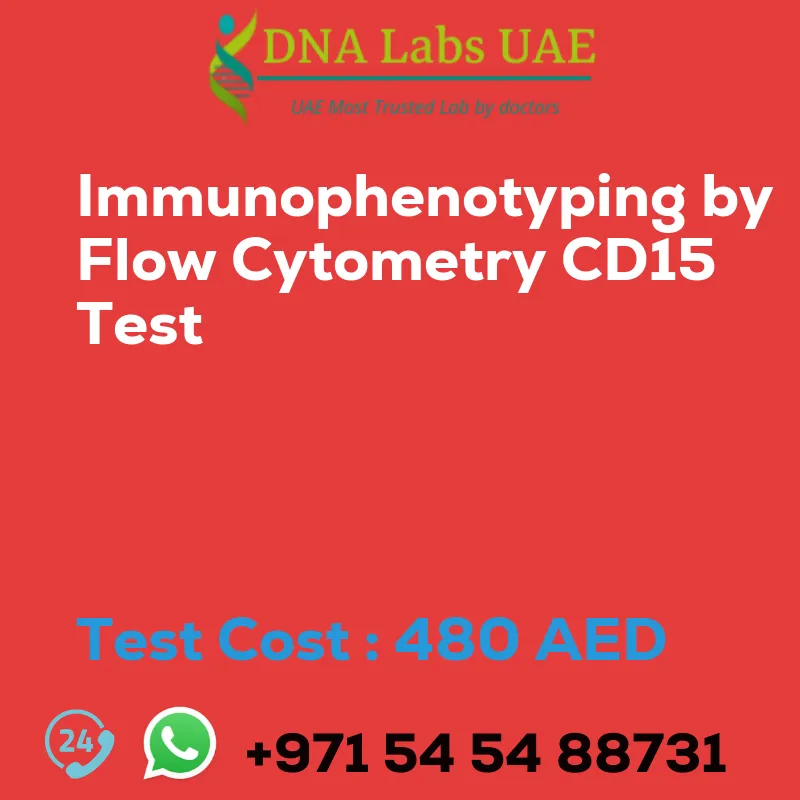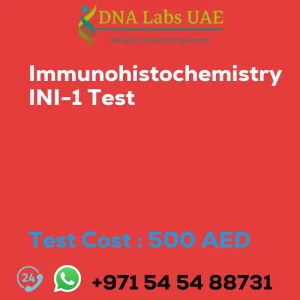IMMUNOPHENOTYPING BY FLOW CYTOMETRY CD15 Test
Test Details
The CD15 test is a flow cytometry-based immunophenotyping test used to identify and quantify the presence of CD15 antigen on the surface of cells. CD15, also known as Lewis X antigen, is a glycoprotein expressed on the surface of granulocytes, monocytes, and some lymphocytes.
The CD15 test is commonly used in the diagnosis and monitoring of various hematological disorders, such as leukemia and lymphoma. It can help differentiate between different types of white blood cells and determine their maturity and activation status.
During the test, a blood or bone marrow sample is collected from the patient. The sample is then treated with fluorescently-labeled antibodies specific to CD15 antigen. These antibodies bind to the CD15 antigen on the surface of cells, allowing for their identification and quantification using flow cytometry.
Flow cytometry is a technique that uses lasers to analyze individual cells as they pass through a narrow channel. The cells are labeled with fluorescent markers, and the laser excites these markers, causing them to emit light at specific wavelengths. The emitted light is then detected and analyzed, allowing for the identification and quantification of cells expressing the CD15 antigen.
Test Components and Price
Test Name: IMMUNOPHENOTYPING BY FLOW CYTOMETRY CD15 Test
Components: CD15 antigen identification and quantification
Price: 480.0 AED
Sample Condition
– 3 mL (2 mL min.) whole blood in 1 Lavender Top (EDTA) tube
– 3 mL (2 mL min.) whole blood in 1 Green Top (Sodium Heparin) tube OR 2 mL (1 mL min.) Bone marrow in 1 Green Top (Sodium heparin) tube
– Ship immediately at 18-22°C. DO NOT REFRIGERATE OR FREEZE.
– Specify time, date, and clinical details on the test request form.
Report Delivery
Sample: Daily by 9 am
Report: Same day
Doctor
Oncologist, Hematologist
Test Department
FLOW CYTOMETRY
Pre Test Information
Give brief clinical history.
Conclusion
The CD15 test is a valuable tool in immunophenotyping by flow cytometry, providing important information about the presence and distribution of CD15-positive cells in hematological disorders. It is just one component of a comprehensive immunophenotyping panel, which may include other markers specific to different cell types. The combination of different markers allows for a more accurate and comprehensive characterization of the patient’s cell population.
The results of the CD15 test can provide valuable information for the diagnosis, prognosis, and treatment planning of various hematological disorders. It is commonly used in the field of oncology and hematology to aid in the management of patients.
| Test Name | IMMUNOPHENOTYPING BY FLOW CYTOMETRY CD15 Test |
|---|---|
| Components | |
| Price | 480.0 AED |
| Sample Condition | 3 mL (2 mL min.) whole blood in 1 Lavender Top (EDTA) tubeAND 3 mL (2 mL min.) whole blood in 1 Green Top (Sodium Heparin) tube OR 2 mL (1 mL min.) Bone marrow in 1 Green Top (Sodium heparin) tube. Ship immediately at 18\u0192??22?\u00f8C. DO NOT REFRIGERATE OR FREEZE. Specify time, date and clinical details on test request form. |
| Report Delivery | Sample Daily by 9 am; Report Same day |
| Method | Flow Cytometry |
| Test type | Cancer |
| Doctor | Oncologist, Hematologist |
| Test Department: | FLOW CYTOMETRY |
| Pre Test Information | Give brief clinical history. |
| Test Details |
The CD15 test is a flow cytometry-based immunophenotyping test used to identify and quantify the presence of CD15 antigen on the surface of cells. CD15, also known as Lewis X antigen, is a glycoprotein expressed on the surface of granulocytes, monocytes, and some lymphocytes. The CD15 test is commonly used in the diagnosis and monitoring of various hematological disorders, such as leukemia and lymphoma. It can help differentiate between different types of white blood cells and determine their maturity and activation status. During the test, a blood or bone marrow sample is collected from the patient. The sample is then treated with fluorescently-labeled antibodies specific to CD15 antigen. These antibodies bind to the CD15 antigen on the surface of cells, allowing for their identification and quantification using flow cytometry. Flow cytometry is a technique that uses lasers to analyze individual cells as they pass through a narrow channel. The cells are labeled with fluorescent markers, and the laser excites these markers, causing them to emit light at specific wavelengths. The emitted light is then detected and analyzed, allowing for the identification and quantification of cells expressing the CD15 antigen. The results of the CD15 test can provide valuable information about the presence and distribution of CD15-positive cells in the patient’s sample. This information can help in the diagnosis, prognosis, and treatment planning for various hematological disorders. It is important to note that the CD15 test is just one component of a comprehensive immunophenotyping panel, which may include other markers specific to different cell types. The combination of different markers allows for a more accurate and comprehensive characterization of the patient’s cell population. Overall, the CD15 test is a valuable tool in immunophenotyping by flow cytometry, providing important information about the presence and distribution of CD15-positive cells in hematological disorders. |







